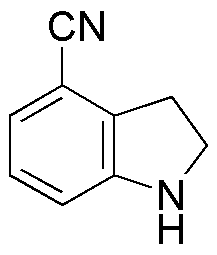2,3-Dihydro-1H-indole-4-carbonitrile is widely utilized in research focused on:
- Pharmaceutical Development: This compound serves as a key intermediate in the synthesis of various pharmaceuticals, particularly in the development of drugs targeting neurological disorders.
- Organic Synthesis: It is employed in organic chemistry for creating complex molecular structures, facilitating the development of new materials and compounds with desirable properties.
- Biological Research: Researchers use it to explore its effects on cellular processes, providing insights into potential therapeutic mechanisms and drug interactions.
- Material Science: The compound is investigated for its potential applications in creating novel polymers and materials, enhancing performance in various industrial applications.
- Agrochemical Formulations: It is also being studied for its potential use in developing agrochemicals, contributing to improved crop protection and yield.
General Information
Properties
Safety and Regulations
Applications
2,3-Dihydro-1H-indole-4-carbonitrile is widely utilized in research focused on:
- Pharmaceutical Development: This compound serves as a key intermediate in the synthesis of various pharmaceuticals, particularly in the development of drugs targeting neurological disorders.
- Organic Synthesis: It is employed in organic chemistry for creating complex molecular structures, facilitating the development of new materials and compounds with desirable properties.
- Biological Research: Researchers use it to explore its effects on cellular processes, providing insights into potential therapeutic mechanisms and drug interactions.
- Material Science: The compound is investigated for its potential applications in creating novel polymers and materials, enhancing performance in various industrial applications.
- Agrochemical Formulations: It is also being studied for its potential use in developing agrochemicals, contributing to improved crop protection and yield.
Documents
Safety Data Sheets (SDS)
The SDS provides comprehensive safety information on handling, storage, and disposal of the product.
Product Specification (PS)
The PS provides a comprehensive breakdown of the product’s properties, including chemical composition, physical state, purity, and storage requirements. It also details acceptable quality ranges and the product's intended applications.
Certificates of Analysis (COA)
Search for Certificates of Analysis (COA) by entering the products Lot Number. Lot and Batch Numbers can be found on a product’s label following the words ‘Lot’ or ‘Batch’.
*Catalog Number
*Lot Number
Certificates Of Origin (COO)
This COO confirms the country where the product was manufactured, and also details the materials and components used in it and whether it is derived from natural, synthetic, or other specific sources. This certificate may be required for customs, trade, and regulatory compliance.
*Catalog Number
*Lot Number
Safety Data Sheets (SDS)
The SDS provides comprehensive safety information on handling, storage, and disposal of the product.
DownloadProduct Specification (PS)
The PS provides a comprehensive breakdown of the product’s properties, including chemical composition, physical state, purity, and storage requirements. It also details acceptable quality ranges and the product's intended applications.
DownloadCertificates of Analysis (COA)
Search for Certificates of Analysis (COA) by entering the products Lot Number. Lot and Batch Numbers can be found on a product’s label following the words ‘Lot’ or ‘Batch’.
*Catalog Number
*Lot Number
Certificates Of Origin (COO)
This COO confirms the country where the product was manufactured, and also details the materials and components used in it and whether it is derived from natural, synthetic, or other specific sources. This certificate may be required for customs, trade, and regulatory compliance.


